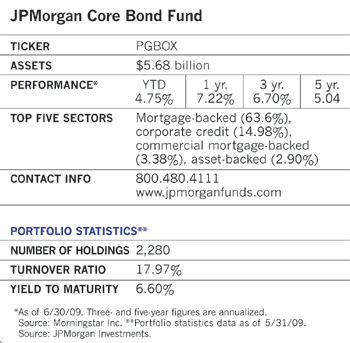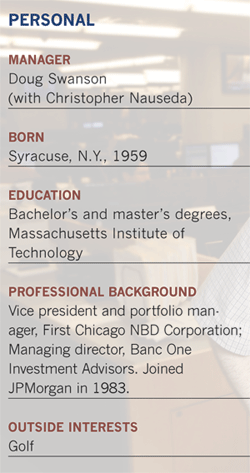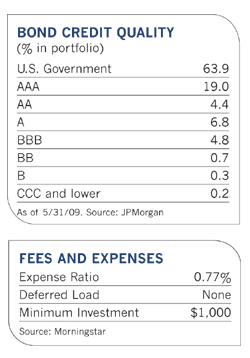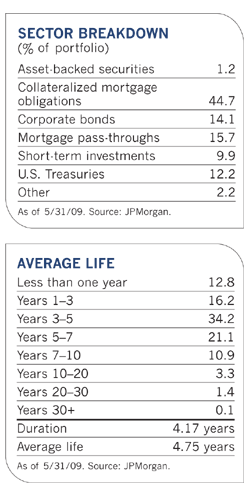Although the bond market has stabilized since the beginning of the year, the recession continues to promise further volatility, says Doug Swanson, manager of the JP Morgan Core Bond fund. "The economic fallout doesn't seem to be as bad as some people thought it would be initially, but it's going to take a couple of years for things to really start turning around," he says.
He takes a similarly guarded view about future fund performance. "People shouldn't buy a conservative fund like this and expect considerable price appreciation, especially in this environment. But it is reasonable to look at the yield of the fund and anticipate a similar total return over a longer time horizon." As of early June, the SEC 30-day yield stood at 5.35%.
An uncertain economy would not necessarily be bad news for the JP Morgan Core Bond fund. Indeed, it might prompt investors to gravitate toward investments seen as safer, including the government-backed securities and investment-grade bonds Swanson's been focusing on since he took the helm of the fund nearly 17 years ago. Since March, though, the bond market's more aggressive corners, such as high-yield bonds, have shot ahead as investors become more comfortable taking risk to achieve unusually high yields. Through June 5, high-yield bond funds delivered a year-to-date total return of 21.61% and bank loan funds jumped 23.87%, according to Morningstar. More conservative intermediate-term government bond funds, which are typically loaded with Treasury securities, remained flat. The JP Morgan Core Bond fund, meanwhile, has crept up just a few percentage points.
This year's performance dispersion among bond market sectors represents an about-face from last year, when shell-shocked investors fled anything that had even a whiff of risk and moved into ultra-safe bonds such as Treasurys. As investor appetite for risky securities has grown in 2009, however, the prices of 10-year Treasury securities have fallen while yields have risen from a little over 2% in December to 3.85% at the beginning of June. At the same time, junk bond prices have shot up and yields have dropped, compressing the yield spread between the two ends of the fixed-income credit quality spectrum. Meanwhile, the yield premium on mortgage-backed securities has also evaporated-from about 3% over Treasurys to about 50 basis points over-as the government plans an intervention to shore up MBS prices and assure investors the market will not implode.
The market was initially skeptical of early policy statements by the new administration, says Swanson. But the Treasury's announcement of its Public-Private Investment Program (PPIP) and its announcement that it would purchase agency mortgage-backed securities helped calm jittery investors. PPIP will use $75 billion to $100 billion in Troubled Asset Relief Program (TARP) money and capital from private investors to buy $500 billion to $1 trillion of toxic assets off the books of banks.
"The improvement in the mortgage-backed securities market this year," says Swanson, "shows investors are confident that the federal government will do everything possible to stand behind the Fannie Mae and Freddie Mac securities."
Whether investors will move toward riskier junk bonds or back to the shelter of safe, secure Treasury and government-backed securities depends largely on how confident they feel about the economy. Consumer confidence is rising to its highest levels since last fall, notes JP Morgan chief market strategist David Kelly, while manufacturing activity and home sales are showing signs of life. Most major financial institutions reported profits for the first quarter of the year following the huge write-downs of 2008.
On the other hand, the U.S. may still see barriers to economic growth, such as high unemployment, a possible spike in oil prices, tight credit conditions and a possible renewed financial crisis stemming from problems in commercial real estate.
"It is still too early to call an economic turning, point," says Kelly. "The unemployment rate continues to rise, housing starts and vehicle sales have yet to make a definitive move upwards and investment spending is still slumping."
Navigating The Mortgage Maze
Swanson won't opine on where he thinks the economy is headed, preferring to leave the job to economists at his firm. He also won't comment on whether investor taste for risk will continue to sharpen this year, which would favor junk bonds over the securities in his fund's more staid portfolio.
Instead, he and his team of analysts prefer to take a ground-level approach by methodically plodding through the vast mortgage-backed bond market to find securities with risk and prepayment characteristics that fit their strategy.
Sixty-three percent of the fund's assets are in mortgage-backed bonds, which is nearly twice the Morningstar category average. Only 13% of the fund is in Treasury securities, which is just half the weighting used in its benchmark, the Barclays Capital U.S. Aggregate Bond Index. The rest is in a mix of corporate bonds and cash.
To help limit risk, Swanson invests in more than 2,200 securities and keeps well under 10% of the fund's assets in the top ten holdings. By contrast, the average bond fund has less than half that number of securities and keeps more than 40% of its assets in the top ten positions. "We don't have any big positions in one name because the goal isn't to hit a home run with one particular credit," he says.
Indeed, consistency and a remarkable lack of surprises have been the fund's hallmarks since inception, rather than its outperformance. Over the last three years, its net asset value per share has hovered at close to $10. In the last year, a volatile time for the bond market, its net asset value has moved in a tight range, from a low of $10.25 in October 2008 to a high of $10.90 in May 2009.
"The result has been a smooth, profitable ride for shareholders," notes Morningstar analyst Greg Brown in a recent report. "The fund's ten- and 15-year returns are among the best in the category. And its long-term risk measures, such as standard deviation, are meaningfully better than most peers'. This mutual fund earns our endorsement."
Given the wobbliness of the real estate market and the threat of rising interest rates, it would likely be challenging for any portfolio manager to continue inspiring confidence in bond investors. But over his 17-year tenure at the fund, Swanson has proved adept at battling difficult market conditions by analyzing and pegging duration and quality and by uncovering the characteristics that make each bond unique. The goal is to meld together securities with different maturities to achieve a portfolio duration similar to that of the benchmark, which is currently about four years.
Swanson also generally steers clear of bonds when it is unlikely that the borrowers will make prepayments on their debt in a refinancing. Such bonds would likely have a very long average life, and thus would be hit particularly hard if rates went up. The securities in his danger zone include those bonds derived from newly issued mortgages with low rates, because new home owners are unlikely to refinance. It's also unlikely that borrowers would make prepayments on or refinance bonds backed by low-rate mortgages with low remaining balances-because the cost of refinancing would likely be higher than the savings for the home owners.
Swanson furthermore looks at geographic locations, often drilling down to the ZIP code, and aims for diversity. In New York, for example, prepayments are less likely than in many other states because refinancing costs tend to be higher. Loan-to-value ratios are also critical, since someone with a mortgage roughly equivalent to the value of a house is more likely to face foreclosure than a home owner with ample equity.
While he's melding together bonds of varying duration, Swanson keeps an eye on mortgage interest rate trends. He believes the slow housing market is likely to keep a lid on any significant rate increases in the near future. "If mortgage rates rose to 8%, the housing market could sink into a depression-style scenario," he says. "The government gets that the mortgage market needs to be functional for the economy to improve."
The fund also has a presence in corporate securities. The corporate market began the year on a sour note but began improving in April as the economy showed signs of life and high yields attracted investors. Swanson took advantage of wide yield spreads earlier in the year to buy a mix of bonds issued by banks, utilities and industrial companies. Now that the risk premium has dwindled, individual security selection matters more than it did earlier in the year, he says.
And while there are still good buys in the corporate area, they are harder to find than they were a few months ago.
Because the fund has less in Treasury securities than its benchmark, its performance suffered last year when investors' risk aversion peaked. That underweighting, however, has helped the fund in 2009 as investors have inched back into beaten down corporate and mortgage bonds. With the Treasury issuing more securities and the budget deficit widening, there is a danger that an oversupply of bonds could drive down prices and raise yields. At the same time, the higher yields on Treasurys now available are making them more attractive than riskier securities than they were just a few months ago. With yield spreads narrowing, Swanson says he's now looking at upping the fund's stake in that ultra-safe corner of the bond market.



